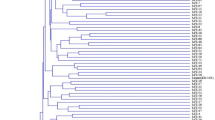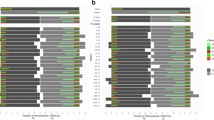Abstract
The Northwestern Argentina (NWA) highland region is one of the southernmost areas of native maize cultivation. We studied variations of different cytological parameters, such as DNA contents, presence/absence of B chromosomes (Bs), and number and sequence composition of heterochromatic knobs in ten accessions of four maize landraces growing along a broad altitudinal cline in NWA. The aim of this work was to assess variations in cytological parameters and their relationship with the crop altitude of cultivation, in an adaptive context. The A-DNA content of the A chromosome complements showed 40% of difference between the lowest (4.5 pg) and the highest (6.3 pg) 2C value. This variation could be attributed to differences in number and size of heterochromatic knobs. Fluorescent in situ hybridization studies revealed the sequence composition of each knob, with a higher proportion of knobs composed of 180-bp repeats rather than TR-1 repeats, in all accessions. We also found numerical polymorphisms and the highest frequency of Bs reported in maize to this date. These results lead us to propose that the frequencies and doses of Bs are influenced by the landrace genotypical make-up. The Bs might be maintained in higher frequencies in those accessions having lower heterochromatin content, so as to preserve an optimal nucleotype. Furthermore, selective forces acting along the altitudinal gradient might be modulating the cytological parameters studied, as suggested by the significant correlations found among them.



Similar content being viewed by others
References
Ananiev EV, Phillips RL, Rines HW (1998) A knob associated tandem repeat in maize capable of forming fold-back DNA segments: are chromosome knobs megatransposons? Proc Natl Acad Sci USA 95:10785–10790
Ayonoadu UW, Rees H (1971) The effects of B-chromosomes on the nuclear phenotype in root meristems of maize. Heredity 27:365–383
Bennett MD (1972) Nuclear DNA content and minimum generation time. Proc R Soc Lond B 181:109–135
Bennett MD (1987) Variation in genomic form in plants and its ecological implications. New Phytol 106:177–200
Bennett MD, Leitch IJ (2005) Nuclear DNA amounts in angiosperms: progress, problems and prospects. Ann Bot 95:45–90
Bilinski P, Albert PS, Berg JJ, Birchler JA, Grote M, Lorant A, Quezada J, Swarts K, Yang J, Ross-Ibarra J (2017) Parallel altitudinal clines reveal adaptive evolution of genome size in Zea mays. BiorXiv. https://doi.org/10.1101/134528
Bracco M, Lia VV, Gottlieb AM, Cámara Hernández J, Poggio L (2009) Genetic diversity in maize landraces from indigenous settlements of Northeastern Argentina. Genetica 135:39–49
Bretting PK, Goodman MM (1989) Karyological variation in Mesoamerican races of maize and its systematic significance. Econ Bot 43:107–124
Bullock D, Rayburn AL (1991) Genome size variation in Southwestern US Indian maize populations may be a function of effective growing season. Maydica 36:247–250
Cámara Hernández J, Miante Alzogaray AM, Bellon R, Galmarini AJ (2012) Razas del noroeste argentino. In: Facultad de Agronomía, Universidad de Buenos Aires (ed) Razas de maíz nativas de la Argentina, vol 1. Buenos Aires, p 192
Cheng YM, Lin BY (2003) Cloning and characterization maize B chromosome sequences derived from microdissection. Genetics 164:299–310
Chiavarino AM, Rosato M, Naranjo CA, Camara Hernandez J, Poggio L (1995) B chromosome polymorphism in N.W. Argentine populations of maize. Maize Genetics Cooperation Newsletters. http://www.agron.missouri.edu/mnl/69/108chiavarino.html
Daniel WW (1990) Applied nonparametric statistic. PWS-Kent Publ, Devon
Di Rienzo JA, Casanoves F, Balzarini MG, Gonzalez L, Tablada M, Robledo CW (2012) Grupo Infostat, FCA, Universidad Nacional de Córdoba, Argentina. http://www.infostat.com.ar
Díez CM, Gaut BS, Meca E, Scheinvar E, Montes-Hernandez S, Eguiarte LE, Tenallion MI (2013) Genome size variation in wild and cultivated maize along altitudinal gradients. New Phytol 199:264–276
Doležel J, Greilhuber J, Lucretti S, Meister A, Lysák MA, Nardi L, Obermayer R (1998) Plant genome size estimation by flow cytometry: inter-laboratory comparison. Ann Bot 82:17–26
Fourastié MF (2015) Estudios citogenéticos en razas de maíz del NOA: Caracterización cariotípica, evaluación del tamaño del genoma y frecuencia de cromosomas B. Dissertation. Universidad de Buenos Aires
González GE, Comas C, Confalonieri VV, Naranjo C, Poggio L (2006) Genomic affinities between maize and Zea perennis using classical and molecular cytogenetic methods (GISH-FISH). Chrom Res 14:629–635
González GE, Fourastié MF, Poggio L (2013) Relevancia del número y composición de secuencias de los nudos cromosómicos en la caracterización de maíz y teocintle. Rev Fitotec Mex 36:127–135
Greilhuber J, Leitch IJ (2013) Genome size and the phenotype. In: Leitch IJ, Greilhuber J, Dolezel J, Wendel JF (eds) Plant genome diversity, vol 2. Springer, Vienna, pp 323–340
Ho I, Rayburn AL (1991) The relationship between chloroplast number and genome size in Zea mays ssp. mays. Plant Sci 74:255260
Jin W, Lamb JC, Vega JM, Dawe RK, Birchler JA, Jiang J (2005) Molecular and functional dissection of maize B chromosome centromere. Plant Cell 17:1412–1423
Kanizay LB, Albert PS, Birchler JA, Dawe K (2013) Intragenomic conflict between the two major knob repeats of maize. Genetics 194:81–89. https://doi.org/10.1534/genetics.112.148882
Kato TA (1976) Cytological studies of maize (Zea mays L.) and teosinte (Zea mexicana Schrader Kuntze) in relation to their origin and evolution. Bull Mass Agric Exp Stn 635:1–185
Kato TA, Mapes C, Mera IM, Serratos JA, Bye RA (2009) Origen y diversificación del maíz: una revisión analítica. In: Galindo Leal C (ed) Universidad Nacional Autónoma de México, Comisión Nacional para el conocimiento y uso de la biodiversidad, vol 1. México DF, p 116
Lamb JC, Meyer JM, Corcoran B, Kato A, Han F, Birchler JA (2007) Distinct chromosomal distributions of highly repetitive sequences in maize. Chrom Res 15:33–49
Laurie DA, Bennett MD (1985) Nuclear DNA content in the genera Zea and Sorghum. Intergeneric, interespecific and intraspecific variation. Heredity 55:307–313
Lia VV, Confalonieri VA, Poggio L (2007) B chromosome polymorphism in maize landraces: adaptive vs demographic hypothesis of clinal variation. Genetics 107:896–904
Lia VV, Poggio L, Confalonieri VA (2009) Microsatellite variation in maize landraces from Northwestern Argentina: genetic diversity, population structure and racial affiliations. Theor Appl Genet 119:1053–1067
Mason RL, Gunst RF, Hess JL (2003) Statistical design and analysis of experiments: with applications to engineering and science, 2nd edn. Wiley, New Jersey
McClintock B, Kato TA, Blumenschein A (1981) Constitución cromosómica de las razas de maíz. Su significado en la interpretación de relaciones entre las razas y variedades en las Américas. Colegio de Postgraduados. Chapingo, México
McMurphy LM, Rayburn AL (1991) Genome size variation in maize populations selected for cold tolerance. Plant Breed 106:190–195
McMurphy LM, Rayburn AL (1992) Chromosomal and cell size analysis of cold tolerant maize. Theor Appl Genet 84:798–802
Mondin M, Santos-Serejo JA, Bertão MR, Laborda P, Pizzaia D, Aguiar-Perecin MLR (2014) Karyotype variability in tropical maize sister inbred lines and hybrids compared with KYS standard line. Front Plant Sci 5:1–12
Peacock WJ, Dennis ES, Rhoades MM, Pryor AJ (1981) Highly repeated DNA sequences limited to knob heterochromatin in maize. Proc Natl Acad Sci USA 78:4490–4494
Poggio L, Rosato M, Chiavarino AM, Naranjo CA (1998) Genome size and environmental correlations in maize (Zea mays ssp. mays, Poaceae). Ann Bot 82:107–115
Porter HL, Rayburn AL (1990) B-chromosome and C-band heterochromatin variation in Arizona maize populations adapted to different altitudes. Genome 33:659–662
Price HJ (1988) DNA content variation within angiosperm species. Ann Mo Bot Gard 75:1248–1257
Puertas MJ, Jimenez G, Manzanero S, Chiavarino AM, Rosato M, Naranjo CA, Poggio L (2000) Genetic control of B chromosome transmission in maize and rye. In: Olmo E, Redi CA (eds) Chromosomes today, vol 13, Birkhäuser Verlag, Switzerland pp 79–91
R Development Core Team (2015) R: a language and environment for statistical computing. R Foundation for Statistical Computing, Vienna
Rayburn AL (1990) Genome size variation in Southern United States Indian maize adapted to various altitudes. Evol Trend Plant 4:53–57
Rayburn AL, Auger JA (1990) Genome size variation in Zea mays ssp. mays adapted to different altitudes. Theor Appl Genet 79:470–474
Rayburn AL, Price HJ, Smith JD, Gold JR (1985) C-band heterochromatin and DNA content in Zea mays. Am J Bot 72:1610–1617
Rayburn AL, Auger JA, Benzinger EA, Hepburn AG (1989) Detection of intraspecific DNA content variation in Zea mays L. by flow cytometry. J Exp Bot 40:1179–1183
Rayburn AL, Biradar DP, Bullock DG, McMurphy LM (1993)) Nuclear DNA content in F1, hybrids of maize. Heredity 70:294–300
Rayburn AL, Dudley JW, Biradar DP (1994) Selection for early flowering results in simultaneous selection for reduced nuclear DNA content in maize. Plant Breed 112:318–322
Realini MF, Poggio L, Cámara-Hernández J, González GE (2016) Intra-specific variation in genome size in maize: cytological and phenotypic correlates. AoB Plants 8:plv138
Reeves A, Tear J (2000) MicroMeasure for Windows, version 3.3. http://rydberg.biology.colostate.edu/MicroMeasure/
Rosado TB, Clarindo WR, Carvalho CR (2009) An integrated cytogenetic, flow and image procedure used to measure the DNA content of Zea mays and B chromosomes. Plant Sci 176:154–158. https://doi.org/10.1016/j.plantsci.2008.10.007
Rosato M, Chiavarino A, Naranjo CA, Cámara Hernández J, Poggio L (1998) Genome size and numerical polymorphism for B-chromosome races of maize (Zea mays ssp. mays, Poaceae). Am J Bot 85:168–174
Rozen S, Skaletsky H (2000) Primer3 on the www for general users and for biologist programmers. Methods Mol Biol 132:365–386
Tito C, Poggio L, Naranjo CA (1991) Cytogenetics studies in the genus Zea: DNA content and heterochromatin in species and hybrids. Theor Appl Genet 83:58–64
Acknowledgements
The authors wish to thank to the loving memory Ing. Agr. Julián Cámara-Hernández (Laboratorio Vavilov, Facultad de Agronomía, Universidad de Buenos Aires) for his dedication, invaluable assistance, and taxonomic determination of all the materials used; to Dr. Verónica Lia (Laboratorio de Biotecnología, Instituto Nacional de Tecnología Agropecuaria, Argentina) for sharing seeds from VAV 6482 of Orgullo Cuarentón landrace; to Dr. Jaroslav Doležel (Laboratory of Molecular Cytogenetics and Cytometry, Institute of Experimental Botany, Czech Republic) for sharing Pisum sativum cv. Citrad seeds; to Dr. Gerardo Cueto (Facultad de Ciencias Exactas y Naturales, Universidad de Buenos Aires) for his helpful advice with the statistical analyses; to Lic. Lucía Babino (IEGEBA, UBA-CONICET) for her support with the graphics, and to Mr. Diego Fink for his technical assistance improving the cytological figures. This research was funded by grants from the University of Buenos Aires (UBACYT 20020130100694BA), and the National Council of Scientific Research (CONICET-PIP 11220120100107CO). The authors are fellows of CONICET.
Author information
Authors and Affiliations
Corresponding author
Electronic supplementary material
Below is the link to the electronic supplementary material.
Rights and permissions
About this article
Cite this article
Fourastié, M.F., Gottlieb, A.M., Poggio, L. et al. Are cytological parameters of maize landraces (Zea mays ssp. mays) adapted along an altitudinal cline?. J Plant Res 131, 285–296 (2018). https://doi.org/10.1007/s10265-017-0996-3
Received:
Accepted:
Published:
Issue Date:
DOI: https://doi.org/10.1007/s10265-017-0996-3




